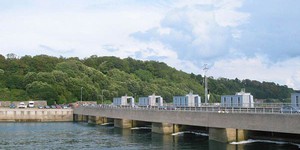Others Like “Track the Journey of Harbor Porpoises” (top 20 results)
|
How does temperature vary with latitude? What happens as you move away from the equator? Test this by comparing weather data from weather stations at different latitudes. (FI, 2006; GLOBE, 2006; NCAR, 2006; NOAA, 2006; Unisys, 2006; Weather Underground, 2006; WMO, 2006)
Read more
The oceans are a precious natural resource, part of Earth's carbon cycle. But what happens if the oceans absorb too much carbon dioxide? Many scientists are concerned that the increased absorption of carbon dioxide is causing them to become more acidic. What impact does that have on the marine life? In this ocean science fair project, you will demonstrate ocean acidification and investigate the effect on the shells of marine life.
Read more
Ocean currents have a huge impact on our weather. If not for the ocean currents, the global climate would be similar to an ice age. Do you live near the coast? Find out which currents are near your coastline. How do they affect your climate? Where do they come from? Do they bring colder or warmer water to your area? Are they seasonal? What do you think your area would be like without them? Every three to seven years there is a weather phenomenon called El Niño, which is caused by…
Read more
You can investigate how the geography of an area makes it prone to severe flash floods. Some areas, typically gullies or canyons, can flood extremely rapidly making it impossible to escape a flash flood. Compare the topography, or geographical shape, or these areas. What makes them prone to flash floods? Can you do an experiment showing how the flow of water increases as a channel narrows? Can you use topological maps of your region to identify areas at risk for flash floods? (NCAR, 2006;…
Read more
Renewable energy is the energy that is extracted from natural sources, such the Sun (solar), earth (geothermal), wind, and water (hydropower). These sources are renewable because they can be replenished by the same natural sources within a short period of time. Hydropower energy is extracted from moving water, like ocean wave energy and tidal energy. In this energy science fair project, you will make a model of a tidal barrage (also known as a dam) and investigate how emptying the tidal barrage…
Read more
Let's suppose you can take advantage of the Internet and get a 'pen pal' located a 1000 miles away in another city. On the same night, and at EXACTLY the same time 'Universal Time', make a CAREFUL observation of where the Moon is located with respect to the background stars. You should be able to discern a slight (about 1/2 the Moon's diameter) shift in position due to parallax. Then, with a little geometry, you could estimate the distance of the Moon during the full lunar cycle (Odenwald,…
Read more
How is geology important for our energy resources? Coal, oil, and natural gas are formed by geological processes over millions of years. Certain geological formations can indicate a reservoir of coal, oil, or natural gas. Also, geothermal processes can be used as an energy resource. How are these formations identified? How are the resources extracted? You can use the National Geospatial Program to access, view, and download information from geospatial databases containing a broad spectrum…
Read more
Make a pinhole projector (see Measuring the Diameter of the Sun and the Moon). Use the pinhole to project an image of the Sun onto a wall or a piece of paper. Do you notice any dark spots on the projected image? Trace the projected image and count the dark spots. Use your pinhole projector to make images of the Sun at the same time of day for several consecutive days. How does the pattern of spots change? Can you use your data to figure out how fast the Sun rotates? Sunspot activity rises…
Read more
What do knots, maps, mazes, driving directions, and doughnuts have in common? The answer is topology, a branch of mathematics that studies the spatial properties and connections of an object. Topology has sometimes been called rubber-sheet geometry because it does not distinguish between a circle and a square (a circle made out of a rubber band can be stretched into a square) but does distinguish between a circle and a figure eight (you cannot stretch a figure eight into a circle without…
Read more
You can measure the diameter of the Sun (and Moon) with a pinhole and a ruler! All you need to know is some simple geometry and the average distance between the Earth and Sun (or Moon). An easy way to make a pinhole is to cut a square hole (2-3 cm across) in the center of a piece of cardboard. Carefully tape a piece of aluminum foil flat over the hole. Use a sharp pin or needle to poke a tiny hole in the center of the foil. Use the pinhole to project an image of the Sun onto a wall or piece…
Read more
|
Explore Our Science Videos
How Far Can a Sneeze Go?
Change the Reaction Rate of a Foaming Reaction
Delayed Release Pill Challenge







